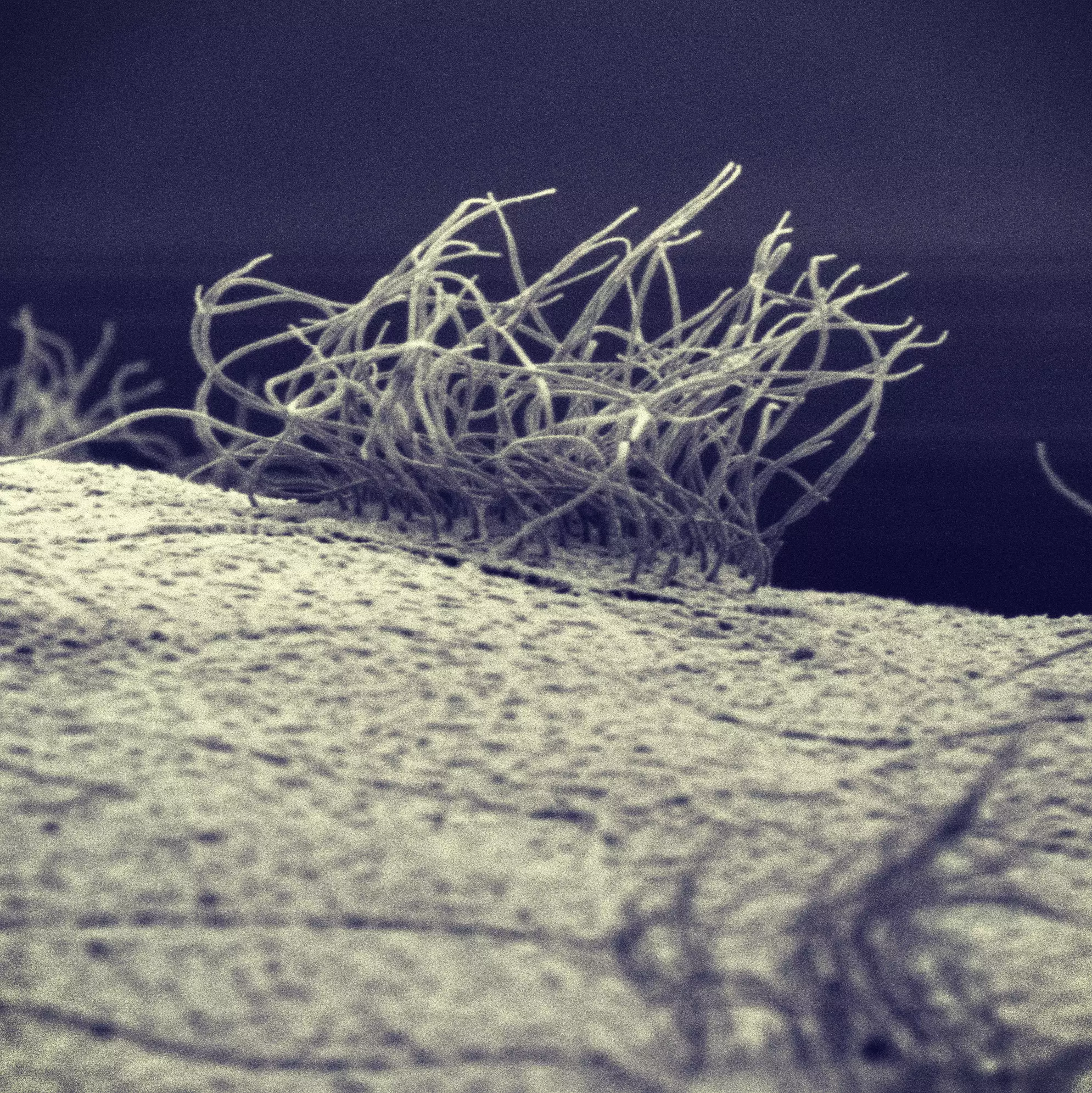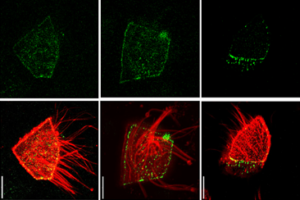Biology of ciliated epithelia
Our goal is to elucidate the molecular and cellular mechanisms underlying the assembly and function of ciliated epithelia in vertebrates
In all vertebrates, specialized ciliated tissues are covered with cells harboring dozens of motile cilia, beating coordinately to generate directional fluid flow. Multiciliated cells help airway cleansing, ovum implantation and cerebrospinal fluid circulation.
Thus, several human pathologies caused by ciliary defects are characterized by chronic respiratory distress, brain abnormalities and reduced fertility. However, the biology of multiciliated cells remains poorly understood, due to the paucity of accessible in vivo models. Our team studies the embryonic skin of the amphibian Xenopus laevis, which is proving very powerful to reveal molecular and cellular principles of multiciliogenesis conserved with humans.
The Xenopus laevis embryo is easily amenable to manipulation of protein-coding genes as well as non-coding RNAs (microRNAs, long non coding RNAs) through micro-injection of mRNA constructs or antisense morpholinos, from the time of fertilization. The ciliated epidermis is particularly suited for functional analysis as it can be targeted specifically and lies at the surface of the embryo, which facilitates light and electron microscopy imaging. This tissue can also easily be exposed to pharmacological compounds and recombinant proteins at various stages of its development, and subjected to transgenesis to trace and manipulate the various cell types that compose it.
Publications
Lrrcc1 and Ccdc61 are conserved effectors of multiciliated cell function
The Scf/Kit pathway implements self-organised epithelial patterning
CDC20B is required for deuterosome-mediated centriole production in multiciliated cells
BMP signalling controls the construction of vertebrate mucociliary epithelia
Control of vertebrate multiciliogenesis by miR-449 through direct repression of the Delta/Notch pathway
Crb3 is required to organize the apical domain of multiciliated cells
Lrrcc1 and Ccdc61 are conserved effectors of multiciliated cell function
A live-imaging protocol to track cell movement in the Xenopus embryo
The Scf/Kit pathway implements self-organised epithelial patterning
ECT2 associated to PRICKLE1 are poor-prognosis markers in triple-negative breast cancer
CDC20B is required for deuterosome-mediated centriole production in multiciliated cells
Notch1 is asymmetrically distributed from the beginning of embryogenesis and controls the ventral center
A Bioresistant Nitroxide Spin Label for In-Cell EPR Spectroscopy: In Vitro and In Oocytes Protein Structural Dynamics Studies.
Animal multicellularity and polarity without Wnt signaling.
Nodal/Activin Pathway is a Conserved Neural Induction Signal in Chordates
Nodal–Activin pathway is a conserved neural induction signal in chordates
Lineage commitment of embryonic cells involves MEK1-dependent clearance of pluripotency regulator Ventx2.
Planar cell polarity in ciliated epithelia.
MicroRNAs as key regulators of GTPase-mediated apical actin reorganization in multiciliated epithelia
Identification of p62/SQSTM1 as a component of non-canonical Wnt VANGL2-JNK signalling in breast cancer.
The PTK7 and ROR2 Protein Receptors Interact in the Vertebrate WNT/Planar Cell Polarity (PCP) Pathway
miR-34/449 control apical actin network formation during multiciliogenesis through small GTPase pathways
BMP signalling controls the construction of vertebrate mucociliary epithelia
Induction and Differentiation of the Xenopus Ciliated Embryonic Epidermis.
Dysregulation of Wnt Inhibitory Factor 1 (Wif1) expression result in aberrant Wnt-β-catenin signaling and cell death of the cloaca endoderm, and anorectal malformations.
Xenopus embryonic epidermis as a mucociliary cellular ecosystem to assess the effect of sex hormones in a non-reproductive context.
On the Origin and Evolutionary History of NANOG.
A gene regulation network controlled by Celf1 protein-rbpj mRNA interaction in Xenopus somite segmentation.
The human PDZome: a gateway to PDZ mediated functions.
Ventx factors function as Nanog-like guardians of developmental potential in Xenopus.
An essential role for transcription before the MBT in Xenopus laevis.
MicroRNA-based silencing of Delta/Notch signaling promotes multiple cilia formation.
Control of vertebrate multiciliogenesis by miR-449 through direct repression of the Delta/Notch pathway
MicroRNA control biosynthesis of motile cilia in vertebrates.
PTK7: a cell polarity receptor with multiple facets.
Protein tyrosine kinase 7 has a conserved role in Wnt/β-catenin canonical signalling.
Distinct Xenopus Nodal ligands sequentially induce mesendoderm and control gastrulation movements in parallel to the Wnt/PCP pathway.
BMP inhibition initiates neural induction via FGF signaling and Zic genes.
Wnt inhibitory factor 1 is epigenetically silenced in human osteosarcoma, and targeted disruption accelerates osteosarcomagenesis in mice.
Neural induction in Xenopus requires early FGF signalling in addition to BMP inhibition.
Role of Siamois before and during gastrulation. In Gastrulation : From cells to embryo
Siamois functions in the early blastula to induce Spemann’s organiser.
A study of Xlim1 function in the Spemann-Mangold organizer.
A new secreted protein that binds to Wnt proteins and inhibits their activities.
Embryonic induction: is the Nieuwkoop centre a useful concept?
A role for the vegetally expressed Xenopus gene Mix.1 in endoderm formation and in the restriction of mesoderm to the marginal zone.
Mutations in ccf, a novel Drosophila gene encoding a chromosomal factor, affect progression through mitosis and interact with Pc-G mutations.
The homeobox gene Siamois is a target of the Wnt dorsalisation pathway and triggers organiser activity in the absence of mesoderm.
News
Lost in translation: Vangl2 short and long
Translation starts with a Methionine: True, but not always, as revealed in a study of the PCP component Vangl2.
Join the IBDM for your internship!
Seeking for your Master internship? The IBDM seems like the right place to do it? Check out our offers.
Thesis Prize from the French Society for Developmental Biology (SFBD) for Alexandre CHUYEN
Alexandre CHUYEN, who did his doctoral thesis under the supervision of Andrea Pasini in the Kodjabachian team, was awarded the 2021 Thesis Prize from the SFBD.
Social distancing : Cells show the way !
A study published in Developmental Cell by the Kodjabachian team reveals how multiciliated cells are distributed at regular intervals in the Xenopus embryonic epidermis.
The selected candidate will receive training in the following areas: molecular biology, cell biology, Xenopus micro-injection and micro-surgery, fluorescent confocal microscopy, video-microscopy, numerical image analysis.


















